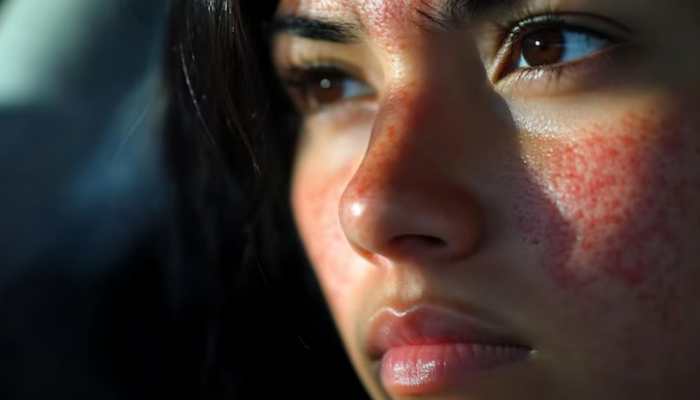Red Spots On The Skin: 10 Causes You Need To Know And How To Treat Them
Red spots on the skin can be caused by various factors, ranging from harmless to signs of underlying health issues. This article explores 10 common causes and offers advice on how to manage them.
- Red spots on the skin can range from harmless to a sign of an underlying health condition.
- It’s important to pay attention to the duration, appearance, and accompanying symptoms of the red spots.
- Red spots on the skin can be alarming, especially when they appear suddenly or without explanation.
Trending Photos
) freepik
freepik Red spots on the skin can be alarming, especially when they appear suddenly or without explanation. While many of these spots are harmless, others may be signs of an underlying health condition. Understanding the potential causes of red spots on the skin can help you determine whether they require treatment or if they will clear up on their own.
We'll explore 10 common causes of red spots and offer guidance on how to address them:-
1. Acne
Acne is one of the most common causes of red spots, especially for teenagers and young adults. Pimples, blackheads, and cysts can all lead to red or inflamed spots on the skin, typically on the face, back, chest, and shoulders.
Why it happens: Acne develops when hair follicles become clogged with oil, dead skin cells, and sometimes bacteria. This leads to inflammation and the formation of red spots or pimples.
How to address it: Over-the-counter products with ingredients like benzoyl peroxide, salicylic acid, or retinoids can help treat acne. If severe, consult a dermatologist for prescription treatments.
2. Allergic Reactions
Allergic reactions to food, medications, or skincare products can cause red spots or hives on the skin. These spots often appear as raised, red, or itchy welts.
Why it happens: When your immune system reacts to a substance it deems harmful, it releases chemicals like histamine, which can cause inflammation and redness on the skin.
How to address it: Avoid the allergen triggering the reaction. Antihistamines can help relieve itching and redness, and in some cases, corticosteroid creams may be needed. Severe reactions, such as swelling of the throat, require immediate medical attention.
3. Heat Rash (Miliaria)
Heat rash, also known as miliaria, occurs when sweat gets trapped in the sweat ducts, causing red, itchy bumps or spots on the skin. This condition is most common in hot, humid weather or during excessive sweating.
Why it happens: Sweating leads to blocked sweat ducts, which can result in red spots or blisters, often in areas like the neck, chest, and back.
How to address it: To prevent heat rash, wear loose-fitting clothing and stay cool. If you already have a heat rash, cool down the affected area and avoid sweating. Over-the-counter hydrocortisone cream can help reduce inflammation and itching.
4. Rosacea
Rosacea is a chronic skin condition that causes redness, visible blood vessels, and red spots or bumps, particularly on the face. It typically affects areas such as the cheeks, nose, forehead, and chin.
Why it happens: The exact cause of rosacea is unknown, but it is believed to involve a combination of genetics and environmental factors, such as sun exposure, stress, or spicy foods.
How to address it: While there is no cure for rosacea, treatments such as topical creams (like metronidazole) or oral antibiotics can help manage the symptoms. Avoiding triggers and using gentle skincare products can also make a difference.
5. Contact Dermatitis
Contact dermatitis occurs when the skin reacts to a substance it comes in direct contact with, such as certain soaps, lotions, or plants like poison ivy.
Why it happens: Your immune system responds to the irritant or allergen, causing red, inflamed spots or blisters.
How to address it: Avoid the offending substance, use cool compresses on the affected area, and apply over-the-counter hydrocortisone creams to reduce inflammation. In severe cases, a healthcare provider may prescribe stronger medication.
6. Psoriasis
Psoriasis is a chronic autoimmune condition that causes the skin to produce new cells too quickly, leading to thick, red patches covered with silvery scales. These patches can appear anywhere on the body but are often found on the elbows, knees, and scalp.
Why it happens: Psoriasis occurs when the immune system mistakenly attacks healthy skin cells, leading to rapid cell turnover and inflammation.
How to address it: While psoriasis cannot be cured, topical treatments like corticosteroids, vitamin D analogs, or biologic medications can help manage the condition. A dermatologist can help determine the best treatment plan.
7. Petechiae
Petechiae are small, pinpoint red or purple spots that appear on the skin due to tiny blood vessels under the skin breaking. They can occur anywhere on the body but are often seen on the legs, arms, or face.
Why it happens: Petechiae can be caused by physical trauma, certain medications, infections, or blood disorders. In some cases, they may indicate a more serious condition, such as a clotting disorder or a viral infection.
How to address it: If petechiae appear without any clear reason or are accompanied by other symptoms like fever or bruising, it’s essential to see a doctor for further evaluation and testing.
8. Chickenpox
Chickenpox is a contagious viral infection that causes an itchy rash made up of red spots and blisters. It primarily affects children, though adults can also contract the virus if they haven’t had it before.
Why it happens: Chickenpox is caused by the varicella-zoster virus and spreads through respiratory droplets or direct contact with the rash.
How to address it: While chickenpox often resolves on its own, treatments such as antiviral medications and over-the-counter remedies for itching (like calamine lotion) can help manage symptoms. A doctor may prescribe antiviral medications if the infection is severe.
9. Infections (Bacterial or Fungal)
Infections, including bacterial infections like impetigo or fungal infections like ringworm, can cause red spots or patches to appear on the skin. These spots can be itchy, painful, or crusty, depending on the type of infection.
Why it happens: Bacterial infections occur when harmful bacteria enter the skin, often through cuts or abrasions. Fungal infections happen when fungi grow on the skin, causing irritation and redness.
How to address it: For bacterial infections, antibiotics (either topical or oral) are typically prescribed. For fungal infections, antifungal creams or oral medications can help clear up the infection.
10. Eczema (Atopic Dermatitis)
Eczema, or atopic dermatitis, is a chronic condition that causes dry, itchy, and inflamed patches of skin. Red spots or rashes may appear anywhere on the body, with common areas being the hands, feet, and behind the knees.
Why it happens: Eczema is linked to an overactive immune response and genetic factors. It can be triggered by environmental factors such as allergens, weather changes, and irritants.
How to address it: Treatment typically involves moisturizing the skin regularly, using anti-inflammatory creams (like corticosteroids), and avoiding known triggers. For severe cases, a dermatologist may recommend additional therapies.
Red spots on the skin can range from harmless to a sign of an underlying health condition. It’s important to pay attention to the duration, appearance, and accompanying symptoms of the red spots. While many causes can be treated with over-the-counter solutions or lifestyle adjustments, more serious conditions require professional medical evaluation and treatment.
If you’re unsure about the cause of your red spots or if they persist or worsen, it’s always best to consult with a healthcare provider or dermatologist. Early diagnosis and treatment can help manage symptoms and prevent further complications.
(This article is meant for informational purposes only and must not be considered a substitute for advice provided by qualified medical professionals.)
Stay informed on all the latest news, real-time breaking news updates, and follow all the important headlines in india news and world News on Zee News.
Live Tv







)
)
)
)
)
)
)
)
)
)
